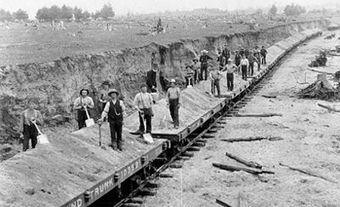Workers' compensation is the name of legislation designed to provide benefits, medical care and rehabilitation services to individuals who suffer workplace injuries or contract occupational diseases. (See also Social Programs in Canada.)

Background
Prior to workers' compensation legislation, workplace accidents were dealt with entirely under the common law (see tort). In practice, this meant that workers could sue employers with some probability of success only if they could establish employer negligence. In the absence of a more widespread compensation plan, many trade unions maintained their own accident funds, but these covered only a minority of the labour force. (See also Working-Class History.)
In 1889 the Royal Commission on the Relations of Labour and Capital reported the high level of injury among workers and condemned the oppressiveness of working conditions in many industries. It made many important recommendations to improve working conditions, but the federal government claimed that to act upon them would constitute an infringement of provincial authority. The premise of modern workers' compensation legislation is that some level of injury is inevitable and that compensation should be provided without regard to responsibility. The Ontario Workmen's Compensation Act of 1914 was the first Canadian statute to accept this principle. It served as a model for provincial legislation in Nova Scotia (1915), British Columbia (1916), Alberta (1918) and New Brunswick (1918). Workers' compensation Acts now exist in all Canadian jurisdictions and provide medical rehabilitation services as well as financial benefits (see Social Programs in Canada).
Did you know?
In 1910, Sir William Ralph Meredith headed a commission to study workers’ compensation. His final 1913 report included what became known as the “Meredith Principles.” These principles served as the foundation for the Ontario Workmen’s Compensation Act of 1914 and other Canadian workers’ compensation legislation.
Compensation
The range of workers covered under compensation varies from province to province. Initially, only workers in hazardous industries were included, but now the law applies to almost every industry and 70–90 per cent of workers are covered. In most jurisdictions, however, agricultural labourers, domestic workers (caregivers), casual workers and outworkers are not covered by the legislation, although in some provinces inclusion can be obtained by application or other special means. Benefit levels are based on previous earnings with the general formula being that 75 per cent of wages are replaced by compensation payments up to a legal maximum.
Financing procedures and contribution rates to workers' compensation funds vary, but in all jurisdictions the fund is financed exclusively by employer contributions. These contributions are calculated on the probability of accident in different industrial groupings. For example, firms in industries with very few accidents and with few employees drawing compensation benefits might pay as little as 25 cents per $100 of payroll, while other firms in industries that record more accidents and more claims on the system might pay $15 per $100 of payroll. The system is similar to an insurance policy in which high-risk customers pay higher premiums. There is substantial concern in most jurisdictions that current large unfunded liabilities of the system will require either further increases in employer contributions or future benefit reductions.
Workers' compensation plays a major role in alleviating hardship caused by injuries or death (see occupational diseases). However, because its major contribution is the provision of compensation after accidents occur, it is only part of a broader set of policies aimed at reducing accidents and producing a safer work environment (see Social Programs in Canada).

 Share on Facebook
Share on Facebook Share on X
Share on X Share by Email
Share by Email Share on Google Classroom
Share on Google Classroom






